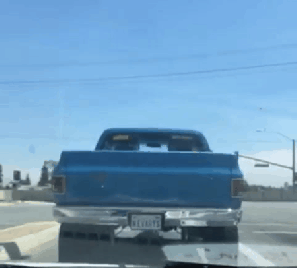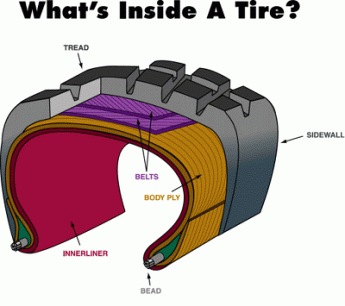Man, I love the fact that Sally has a good set in the front and a banging set in the back. Get your mind out the gutter people, I am talking about my car’s tires. A lot of times, people tend to neglect those four pieces of rubber better known as their tires. A friend of mine was about to head on a road trip and didn’t even notice he had wires showing on his tires. This, if you did not know, is a tire in terrible shape and very unsafe. I will explain that situation later in the article.
There are many issues to look for when it comes to your tires; but, I will only focus on four today.
The Role of Your Tires (besides to roll)
Your tires are key components in your suspension system. They are what keep your car moving, allow your car to drive straight, provide traction to transfer power from your power train, and, in some cases, allow you to make a great presentation at the end of car shows (for burnouts, which I condemn…. if you don’t know what you are doing, of course)

Your tires are also your first shock absorbers. They dampen the impact even before the bumpiness of the road is transferred to your springs and shocks, enabling you to have a smooth ride. Driving with bad tires requires more work from the rest of your suspension system and leaves it even more vulnerable to damage. This is why it is very important to take care of your tires.
You may think your steering wheel is what makes your car turn and move from left to right; but, the real unsung hero is your tires. Your tires are what transfers the movement from the steering system to the road.
And, nope, I’m not done yet! Your wheels are also the component supporting the load of your car. So, be sure to thank your tires the next time you try to pack 10 full grown adults in a five-seater car.

So, what in the world are these tires made of???
Now that you know the roles of the tires, I am sure you are dying to know how these bad boys can be so versatile and just plain AMAZING! Let’s take a look at what makes these all-star parts.

The tread of the tire is the rubber that makes immediate contact with the road. It usually endures the most wear and tear; so, it is the part of the tire most commonly checked. The tread is designed to reduce overall wear, provide a smooth ride, and allow the car to drive on many different surfaces without being damaged.
Underneath the tread is the carcass. (Yeah, not sure why they used that name. Seems pretty dark but oh well.) The carcass is what determines how much load your tires can handle and how strong they are. The carcass is made up of a layer of rubber with metal belts infused in it and the body ply. The carcass is not only on the flat area of the tire under the tread; but, it is also along what is called the “sidewall”. As the name suggests, this is the area on the side of your tire.
Under the carcass is the rubber liner. The rubber liner is a thick piece of rubber that allows you to fill the tire with air. In the past, an innertube was used, similar to bike tires.
Now that you have graduated to a tire master, we can discuss four tires issues you should be aware of.
Bubble in Your Tire

A bubble in your tire can be caused by many different issues and should always be taken very seriously. The most common issue is in the case of you participating in the sport of running over random objects at high speeds (disclaimer: this is not a sport that I condone and those who particpate do not need to be driving a car. At least around me).
Driving over objects, especially at high speeds, causes a large amount of force to be pinpointed to a small area of the tire. This damages the inner lining of the tire resulting in a bubble. A bubble is essentially air pushing against the carcass of the tire, which you learned earlier, provides the strength of the tire.
With damage to the inner lining and carcass, the tire is no longer functioning as it was designed. This can cause premature failure presented as a slow leak or, even worse, a blowout.
Another cause of bubbles in the tire could be a damaged or bent rim. The inner lining, I’m sure you know, is designed for a circular rim. When you have a bent rim, it puts uneven pressure on your tires. This can also damage your tire’s inner lining resulting in a bubble.
Unfortunately, there is no way to repair a bubble in the tire. It is a good idea to get the tire inspected before purchasing a new tire. If it turns out there is no damage to the inner lining of the tire yet there is still a bubble, then this could be a manufacturing issue and you could be eligible for a warranty claim.
In any case, you should never drive with a bubble in your tire. This tire should be replaced with your spare or replaced with a new tire, as soon as possible.
Low Tread

Low tread or balding tires is one of the more common issues found on everyday tires. It is usually a consequence of not getting your tires checked regularly. When your treads get too low they can no longer function as originally designed.
One function of the treads, for example, is to displace water so you can drive in wet conditions. The tread is positioned so that it moves the water away from your tires. When your treads are low they can no longer displace the water which increases your risk of hydroplaning.
With low treads, you also expose the layers underneath to the elements of the road. This exposure can lead to structural damage of the tire. By now, we all know what can happen if the structure of the tire is damaged.
This brings me back to my friend who was planning his road trip with wire showing. His tread was completely gone, exposing the carcass, which was extremely dangerous.
I suggest you replace tires with low treads but in some cases people opt to get their tires re-treaded. This is very common on commercial trucks but not suggested for passenger vehicles. If your treads have been worn down, the overall structure of the tire is also worn. It is much safer to replace the entire tire. Plus, most insurance companies won’t provide coverage if you get in an accident due to tire failure with re-treaded tires.
You can quickly check your tread life by performing the penny test. With the penny test you place a penny in your tread with Abe Lincolns head upside. If you can see his entire head then it may be time to replace your tires.

Missing Cap on Valve Stem (Air Cover)
Have you ever gone to put air in your tire only to notice your valve stem covers are missing?? Maybe the tire installer forgot to put them back on or some petty person decided they just needed your valve stem caps (I have seen this happen smh). Or, it could have just come loose during hard accelerations in your speedy Prius (No shade to Prius owners. Prius are actually amazing cars and surprisingly expensive in some cases). Either way, though a missing valve stem cap might seem like an innocent issue, it can actually cause major problems.

The valve stem cap is used to protect the core stem which allows you to put air in your tire. If dirt and debris get in there and damage this stem, first, it can prevent you from being able to put air in your tire and it can also cause a slow leak.
Unless you have a tire pressure sensor, the air leak can be completely unnoticeable causing you to drive on a flat tire. Driving on a flat tire doesn’t allow the tire be driven as it was originally designed. Driving on a flat tire also causes your sidewall to be in contact with the road. Unlike the treaded portion of your tire, the sidewall cannot withstand the harshness of the road. The structure of the tire is not designed for the side wall to be positioned in that way.
By the time you notice the leak, the damage may already be done and you are now looking at purchasing a new tire. If you notice you are missing a valve stem cover go ahead and replace it. Please, do not be petty and jack some innocent person’s valve stem covers.
Overinflating Tires
Overinflating your tires can’t be that bad. It’s just air! WRONG. Overinflating your tires is very similar to the valve stem issue. Everything may seem ok in the beginning but in the end you and your tires will pay the price.
When your tires are over-inflated the points of contact on the road change. No longer is the full tread or contact patch on the road. The excess air pushes more along the center of the tire causing this area to be the only point of contact on the road.
That doesn’t seem like that big of a deal. It actually seems like it would save the life of the tire since the entire tire isn’t being used. Sounds good in theory; but, in reality, it is doing the complete opposite. Over-inflated tires display uneven wear and, usually, can easily be spotted by a mechanic.

Overinflated tires also have a much harsher and less smooth ride. No longer is the tire absorbing the bumps in the road evenly. Also, with the decrease in surface area, your car is having to work harder during normal driving which decreases your overall fuel economy.
The most damaging consequence of overinflating your tires is damaging your inner lining. The inner lining of your tires is designed for a specified tire pressure. When you put extra stress on the inner lining of the tire and, in turn, on the overall structure of the tire it can no longer perform or last as expected. In worst case scenarios, depending on the age of your tires and the types of roads you drive on, this can lead to tire failure.
When inflating your tire, it is best to follow the manufacturer’s recommended tire pressure. This can be found on the inside of your door for new cars or, as always, is just a quick google search away.
Conclusion
Ok, now that you are a tire expert and you have an overall understanding of the anatomy, functions, and possible issues tires may have, you are ready to conquer the world! Ok, maybe not conquer the world but at least drive safely.
Taking care of your tires is very important. Having your tires checked routinely during oil changes or even getting random inspections before going to work never hurt. It is also a good idea to check your tire pressure regularly if you aren’t as fancy as some people with the high-tech tire pressure monitoring system.
Regular tire rotations are also recommended as a great way to preserve the life of your tires.
I hope I was able to grab your attention long enough for you to roll with me throughout this entire article (no pun intended, well maybe a little). Anyways, for those who made it this far, I leave you with this sound clip so you can keep rolling!
If you have any questions or comments drop them below or send us a message here. We’d love to hear from you. And remember – knowledge is the key to a fair repair.
